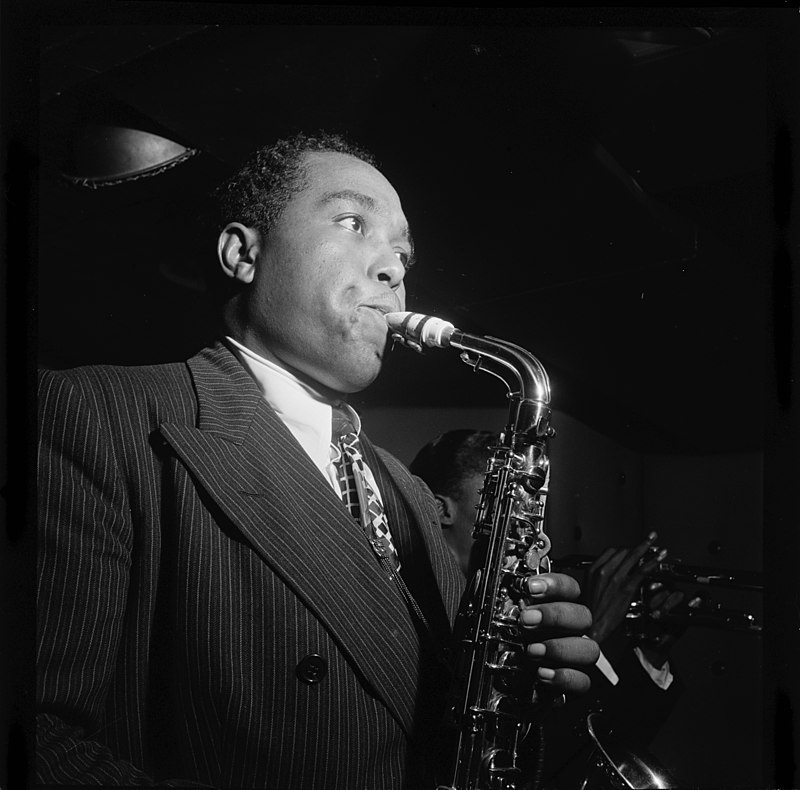**This Charlie Parker stamp is a part of the jazz music set from the Legends of American Music series. Make sure to check out my hub page for this project. Also check out my post on jazz stamps.
It is impossible to overstate the importance of Black musicians to American and world music. One reason why the Legends of American Music series by the USPS is so important is because it features so many Black American musicians across genres. For example, this blog has posts to a few Black music legends on stamps including W.C. Handy, Louis Armstrong, Sister Rosetta Tharpe, and many others. This post is about the postage stamp featuring the the saxophonist Charlie Parker.
Charlie Parker

By William P. Gottlieb, Public Domain,
Charles Parker Jr. was born in Kansas City in 1920. HIs father was a musician, playing the piano and singing on the Theater Owners Booking Association circuit. At the age of eleven, Charlie Jr., began to play the saxophone. Subsequently, at the age of 14 he joined his high school band, studying with Alonzo Lewis. He dropped out of high school when he was fifteen in order to pursue a professional career as a musician.
Famously, Parker began practicing up to fifteen hours a day, every day, and developed into an incredible virtuoso player. He also mastered the ability to improvise. Parker played in local clubs around Kansas City and was influenced by the local style of musicians such as Buster Smith. In a story that has become famous to music history, during one of his early gigs in the spring of 1936, Parker bombed one of his solos onstage. The drummer Jo Jones took a cymbal from his drumset and threw it at Parker’s feet. This was meant to chase the young musician offstage. Instead, it caused Parker to double down and work even harder to become a leading jazz figure. Parker later told this story as being a seminal event in his life.
On his way to play a gig in the Ozarks, Parker was in a car accident that broke three of his ribs and fractured his spine. During his recovery, Parker developed an addition to pain killers and opiods, which led him to heroid. He would struggle with drugs for the rest of his life.
Bebop
Parker moved to New York City in 1939 to finally hit it big in the music world. It is during this period that Parker is credit with developing his new musical ideas that changed the history of jazz music, his new musical style became known as bebop. During the musician strike of 1942-43, Parker played with a group of other young musicians in a Harlem after-hours clubs. This led to his work with Dizzy Gillespie, Charlie Christian, and Thelonious Monk. However, it was only in 1945 that Parker was able to record with some of these other bebop musicians to introduce this style of music to the broader world.
Parker’s fame grew throughout the jazz world and he toured the country and recorded with many other young musicians. He also had interest in classical music, particularly the compositional style of Igor Stravinsky. Parker wanted to incorporate elements of classical music along with jazz, and particularly brought stringed instruments into the typical wind instrument driven jazz band. In 1949, Parker recorded six songs for an album that were arranged to include a chamber orchestra.
Although Parker’s career was just starting, he died in March of 1955 at the age of 1934. He was suffering from advanced cirrhosis and suffered a heart attack. After a large funeral in Harlem, funded by Dizzy Gillespie, Parker was buried in his hometown of Kansas City,.
The Charlie Parker Stamp

United States, 1995
Scott Number 2987
The ten stamps in the jazz musicians set of the Legends of American Music series was issued in 1995. It may be the strongest group of musicians of any of the sets devoted to genres. It includes Louis Armstrong, John Coltrane, Jelly Roll Morton, and Thelonious Monk among others.
The Armstrong stamp was issued on September 1, 1995 in New Orleans. The remaining stamps in the series became available two weeks later on September 16, at the Monterrey Jazz Festival. Like the other stamps in the Legends series, the jazz stamps are lithograph prints of an original acryllic painting. The stamp was created by Black graphic designer Dean Mitchell.
Visually, the jazz stamps are among the best of the Legends series. They look less cartoony than other designs and each stamp has at the top, a faint background of a piano keyboard. This both unifies the set and makes it obvious that the subject is a musician.
Make sure to check out some of Parker’s music. Here is a rare video appearance from 1950.

